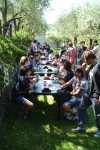Giochiamo a Go nelle scuole: let
| Name: | Giochiamo a Go nelle scuole: let |  |
| Contributor: | Maurizio Parton | |
| Duration: | N.A. | |
| Organisation: | FIGG | |
| Edition: | 2012 | |
| Prize: | European Iwamoto Award 2012 |
Description
The project is structured in four main parts:
1. Providing materials. We wrote a book in Italian language containing the rules and some very basic notions of the game; the book was then sold, at price cost, together with 9x9 plastic or 13x13 wood sets. The book can also be downloaded on the Internet for free. The book+Go set served as a base for the following steps.
2. Training of teachers. We trained 4 teachers through 4 lectures: after a discussion about the educational potential of Go, we gave them historical and cultural fundamentals about the game and we taught them the rules. At the end, these 4 teachers were able to help us in the following step.
3. Lessons in schools. We started a series of courses in Italian schools, covering three levels: primary, middle and high schools. The courses were generally held in the afternoon, after the regular lessons, on voluntary basis; in one case, though, the course has figured as a part of the ordinary activity of the school, and took place in the normal school time. At the present day, the project interested 4 schools, involving about a hundred of students.
4. National Juniores Championship. The first "Campionato Italiano Juniores 13x13" (Italian Junior Championship 13x13) took place on the 17th of June 2012, and saw the presence of 48 participants, from 7 to 19 years old, the most of which were been taught in our courses (we had also some independent participants). You can see the pictures of this extraordinary event here.
Objectives
For what concerns Go, our goals are
1) to spread the game between young and very young generations;
2) to scout for young talents;
3) to spread Go in contexts that would be hard to reach in normal conditions - far from universities, game enthusiasts, Far East connoisseurs, etc.
As teachers, we deeply believe in the educational potential of the game, in particular its ability to develop logical and mathematical skills, to help focusing on specific tasks, and to elaborate strategies to realise ones goals.
Realisation
The most relevant premise for the project to work is that a contact is established between Go world and the school system. In this regard, having suitable relationships (or an ability to establish them) appears to be the main issue. In our case, the fact that one of the organizers of the project (Alessandro Salpietro) works in a primary school as a teacher played quite a significant role in the outcome of the project. Maurizio Parton, as a mathematician, managed to provide useful contacts between middle and high schools teachers of mathematics. Having a Go player (Olivier Turquet) in chief of a publishing house was also very helpful for the first part of the project (providing materials).
Resources
1. Writing the book: 60 hours;
2. Training of teachers: 4 lectures of 3 hours each, 2-5 trainers involved;
3. Lessons in schools: for the primary school, 2 hours per week, during the whole year, 1 Go player teacher. For middle and high school, 3 hours per week, 6 weeks long, trained teachers + 2-5 Go players;
4. Championship: 1 day for the organization, 1 day for the tournament, 6 Go players involved.
From a didactic point of view, the role of direct lessons is - at least with kids - vital and irreplaceable. Older students, instead, can recur to the book to learn the rules (if unable to attend all or some of the lessons), or simply use it to deepen and review what they've learned at school. For what concerns the sets, besides the ones sold with the book (about 25), a wide variety of makeshift sets was put in place. On the Internet, we created a room on KGS ("Giochiamo a Go nelle scuole"), specifically intended for the kids from our schools, that also hosted, once, a little tournament. The most important resource remains, anyway, the willingness of volunteers from the FIGG and the help from the world of Italian teachers and school workers.
Possibilities of copying this project
Referring to the description, in order to copy this project you need:
1. to produce a book stating rules and some tactics in a simple and understandable way, in native language and a cheap 9x9 or 13x13 set;
2. to communicate to the schools that you can train teachers in order for them to support you in giving Go lectures to students;
3. to organize a final event, giving all the students the chance to participate in an actual competition.
Ad. 1: the FIGG released his book under a Creative Commons license, so step 1 reduces to translating the book. If you want to write the book by yourself, we suggest using LaTeX and Igo package. The Go set, book included, should be cheap.
Ad. 2: we produced a letter for schools, which could be translated. Having Go players which are also school teachers would be very helpful.
Ad. 3: the final event is more or less an ordinary tournament: just keep in mind that 7 years old players can be noisier than usual :-) An official acknowledgement from the national Go Association give to the tournament an additional value.